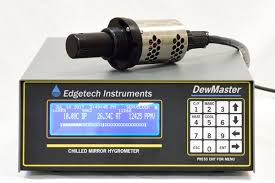In environments where precise humidity control is vital, the chilled mirror hygrometer is the most accurate and reliable method of measuring gas moisture. Chilled mirror technology remains the benchmark standard in laboratories, industrial settings, or meteorological applications due to its direct measurement approach and long-term stability.
This article will explore a chilled mirror hygrometer, how it works, its key benefits, real-world applications, and considerations for choosing the right model.
What Is a Chilled Mirror Hygrometer?
A chilled mirror hygrometer is an instrument designed to measure dew point, frost point, or humidity levels in a gas by cooling a mirror surface until condensation forms. The temperature at which this condensation appears is recorded as the dew point temperature, which correlates directly to the moisture content of the gas.
Unlike other types of humidity sensors that infer moisture based on electrical properties, a chilled mirror hygrometer measures it physically and optically, making it a primary standard in humidity calibration labs and high-precision environments.
How Does a Chilled Mirror Hygrometer Work?
The functionality of a chilled mirror hygrometer revolves around three essential components:
Mirror and Cooling Mechanism: A highly polished mirror is cooled using a thermoelectric cooler (Peltier element).
Optical Sensing: As the mirror cools, water vapour condenses on its surface. An optical detector (typically an LED and photodiode system) detects the change in reflectivity when condensation occurs.
Temperature Measurement: A highly accurate temperature sensor attached to the mirror records the temperature when condensation is detected.
This process is controlled by an internal feedback system stabilising the mirror at the dew point, allowing consistent and repeatable measurements.
Key Advantages of Chilled Mirror Hygrometers
Exceptional Accuracy
Chilled mirror hygrometers offer superior accuracy, typically within ±0.2°C dew point, that far exceeds the capabilities of capacitive or resistive humidity sensors. This is essential in applications where even minor fluctuations in moisture can cause significant issues, such as semiconductor manufacturing or pharmaceutical production.
Long-Term Stability and Reliability
Because chilled mirror hygrometers rely on physical measurements, unlike polymer-based sensors, they are not susceptible to drift over time. This makes them ideal for long-term deployment in critical monitoring applications.
Direct Dew Point Measurement
Unlike sensors that estimate humidity, a chilled mirror hygrometer measures dew point directly, providing more reliable data and reducing the risk of calibration errors.
Versatility
Modern devices can measure dew point, frost point, relative humidity, and even absolute humidity, depending on configuration, offering a comprehensive environmental analysis in one unit.
Applications of Chilled Mirror Hygrometers
Meteorology and Climate Research
Accurate measurement of atmospheric moisture is essential in weather forecasting and climate modeling. Chilled mirror hygrometers provide reliable dew point data across a wide range of temperatures and pressures, including low-humidity environments such as high altitudes.
Pharmaceutical Industry
Humidity control is critical in pharmaceutical production to maintain drug stability and integrity. Chilled mirror hygrometers are commonly used in cleanrooms, storage facilities, and stability chambers for precise monitoring.
Semiconductor and Electronics Manufacturing
Moisture is a major contaminant in semiconductor environments. These hygrometers ensure ultra-low moisture levels are maintained during fabrication processes, preventing defects and increasing product yield.
Calibration and Testing Laboratories
Due to their reliability and traceability, chilled mirror hygrometers are often used as reference instruments to calibrate other humidity sensors, ensuring accuracy in broader instrumentation networks.
Aerospace and Defense
In aerospace applications, environmental conditions must be simulated and controlled with precision. Chilled mirror hygrometers are used in environmental test chambers to replicate and measure extreme atmospheric conditions.
Limitations and Maintenance Considerations
Cost
Chilled mirror hygrometers are significantly more expensive than conventional humidity sensors, reflecting their precision engineering and high-quality components.
Sensitivity to Contamination
The mirror surface must remain clean to function properly. Dust, oil, or particles can interfere with reflectivity and cause false readings. Routine maintenance and filtration of sample gas streams are often required.
Power Consumption and Size
Because they use active cooling and optical systems, chilled mirror devices often require more power and space, which may limit portable or embedded applications.
Recent Innovations in Chilled Mirror Technology
As demand for smart and connected sensors grows, manufacturers have introduced several improvements:
- Self-Cleaning Mirrors: Newer models offer automated mirror cleaning to reduce maintenance downtime.
- Digital Connectivity: Integration with SCADA systems, IoT platforms, and cloud-based monitoring tools for real-time data analysis.
- Portable Models: Compact, battery-powered versions now exist for field use, particularly in environmental monitoring.
These innovations expand the usability of chilled mirror hygrometers across a wider range of environments and industries.
How to Choose the Right Chilled Mirror Hygrometer
When selecting a chilled mirror hygrometer, consider the following factors:
- Required Measurement Range: Choose a device that covers the dew point or humidity range relevant to your application.
- Accuracy and Repeatability: Ensure the device meets your industry’s precision standards.
- Environmental Conditions: Factor in whether the device will be used in cleanroom, outdoor, or industrial settings.
- Data Output: Modern instruments should offer digital output formats like RS-485, Modbus, or Ethernet for integration.
- Maintenance Requirements: Look for models with easy cleaning mechanisms and replaceable components.
Conclusion
The chilled mirror hygrometer remains the definitive standard for high-accuracy humidity measurement. Its ability to provide direct, stable, and repeatable dew point data makes it invaluable across scientific, industrial, and environmental sectors. While it comes with a higher price and maintenance burden, the benefits of precision and reliability are undeniable—especially in applications where humidity control can make or break outcomes.





Comments